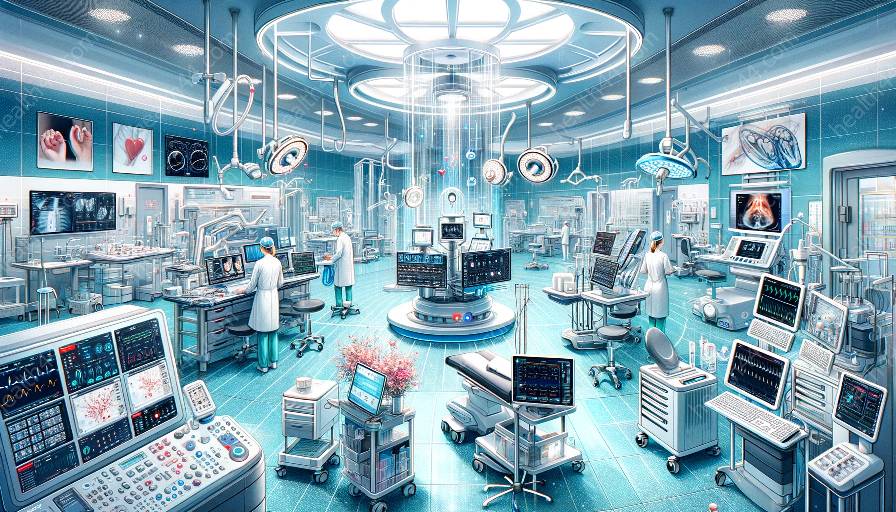The circulatory system, also known as the cardiovascular system, is a remarkable network of organs and vessels responsible for circulating blood and essential nutrients throughout the body. It plays a crucial role in the delivery of oxygen and removal of waste products, making it integral to overall health and well-being. This comprehensive topic cluster delves into the intricate details of the circulatory system, exploring its anatomy, physiology, and the role of medical devices in supporting its functioning.
Anatomy of the Circulatory System
The circulatory system encompasses the heart, blood vessels, and blood. Understanding the anatomy of these components is fundamental in comprehending the system's overall function and significance.
The Heart
The heart is a muscular organ located slightly to the left of the midline of the chest. It consists of four chambers: two atria and two ventricles. The right side of the heart receives deoxygenated blood from the body and pumps it to the lungs for oxygenation, while the left side receives oxygenated blood from the lungs and pumps it to the rest of the body. This continuous pumping action is driven by the rhythmic contractions of the heart muscle, creating the vital force behind blood circulation.
Blood Vessels
Blood vessels form an extensive network that transports blood to and from all areas of the body. They include arteries, veins, and capillaries. Arteries carry oxygen-rich blood away from the heart to the body's tissues, while veins carry oxygen-depleted blood back to the heart. Capillaries, the smallest blood vessels, enable the exchange of nutrients and waste products between the blood and tissues.
Blood
Blood is a specialized connective tissue composed of plasma, red blood cells, white blood cells, and platelets. Plasma carries nutrients, hormones, and waste products, while red blood cells transport oxygen and carbon dioxide. White blood cells play a crucial role in immune function, and platelets are essential for blood clotting.
Physiology of the Circulatory System
Understanding the physiology of the circulatory system involves examining the processes and mechanisms that facilitate effective blood circulation and nutrient delivery.
Blood Circulation
The circulatory system operates as a closed-loop system, with blood continuously flowing from the heart to the body's tissues and back to the heart. This circulation is driven by the coordinated contractions of the heart chambers, which maintain a consistent and efficient flow of blood throughout the body.
Blood Pressure Regulation
The circulatory system regulates blood pressure to ensure adequate perfusion of organs and tissues. This involves intricate mechanisms, including the control of blood vessel diameter, the coordination of heart rate and contractility, and the influence of hormones such as adrenaline and aldosterone.
Gas Exchange
Oxygen and carbon dioxide exchange occurs in the lungs as part of the respiratory system's interaction with the circulatory system. Oxygen from inhaled air diffuses into the blood, while carbon dioxide moves from the blood into the lungs to be exhaled.
Role of Medical Devices
Medical devices play a crucial role in diagnosing, treating, and monitoring conditions related to the circulatory system. They encompass a wide range of technologies designed to support and improve cardiovascular health.
Diagnostic Devices
Tools such as electrocardiograms (ECGs), echocardiograms, and angiography equipment aid in the diagnosis of heart and vascular conditions. These devices provide valuable information about the structure and function of the heart and blood vessels, enabling healthcare professionals to make informed treatment decisions.
Treatment Devices
Medical devices including pacemakers, implantable cardioverter-defibrillators (ICDs), and cardiac stents are used to treat various heart rhythm disorders and vascular blockages. These devices help restore normal heart function and improve blood flow in cases of arterial narrowing or blockage.
Monitoring Devices
Devices such as blood pressure monitors, pulse oximeters, and cardiac monitors enable ongoing monitoring of cardiovascular health. They provide valuable data for assessing heart function, blood oxygen levels, and overall circulatory status, assisting in the management of cardiovascular conditions.
Conclusion
The circulatory system is a marvel of biological engineering, seamlessly coordinating the flow of blood, nutrients, and oxygen to sustain life. Understanding its anatomy, physiology, and the pivotal role of medical devices sheds light on the intricate mechanisms that support cardiovascular health and function. By delving into this comprehensive topic cluster, one gains a deeper appreciation for the inner workings of the circulatory system and the technological advancements that contribute to its well-being.


